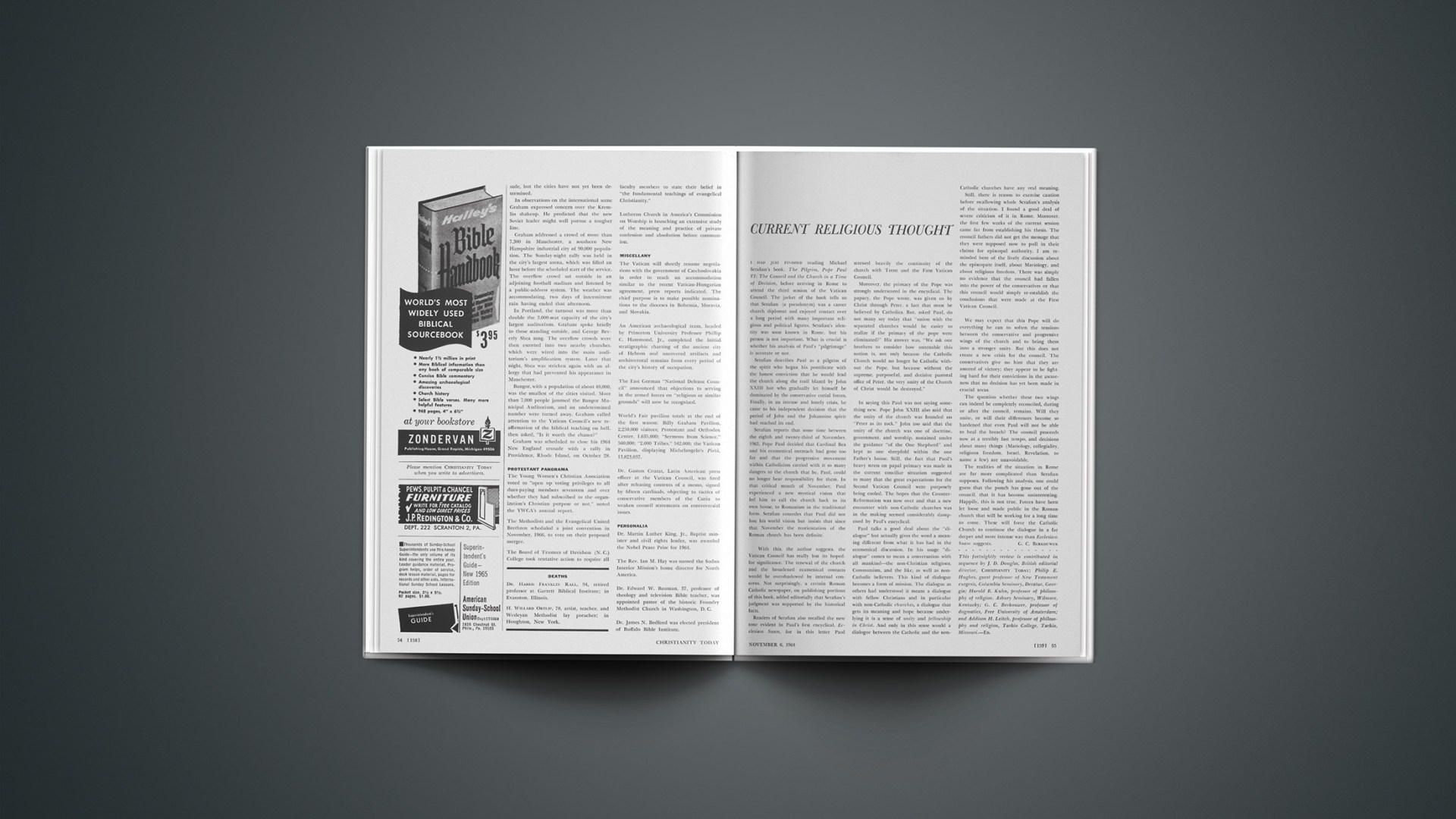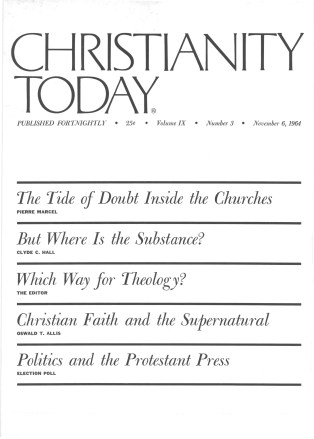I had just finished reading Michael Serafian’s book, The Pilgrim, Pope Paul VI: The Council and the Church in a Time of Decision, before arriving in Rome to attend the third session of the Vatican Council. The jacket of the book tells us that Serafian (a pseudonym) was a career church diplomat and enjoyed contact over a long period with many important religious and political figures. Serafian’s identity was soon known in Rome, but his person is not important. What is crucial is whether his analysis of Paul’s “pilgrimage” is accurate or not.
Serafian describes Paul as a pilgrim of the spirit who began his pontificate with the honest conviction that he would lead the church along the trail blazed by John XXIII but who gradually let himself be dominated by the conservative curial forces. Finally, in an intense and lonely crisis, he came to his independent decision that the period of John and the Johannine spirit had reached its end.
Serafian reports that some time between the eighth and twenty-third of November, 1963, Pope Paul decided that Cardinal Bea and his ecumenical outreach had gone too far and that the progressive movement within Catholicism carried with it so many dangers to the church that he, Paul, could no longer bear responsibility for them. In that critical month of November, Paul experienced a new mystical vision that led him to call the church back to its own house, to Romanism in the traditional form. Serafian concedes that Paul did not lose his world vision but insists that since that November the reorientation of the Roman church has been definite.
With this, the author suggests, the Vatican Council has really lost its hoped-for significance. The renewal of the church and the broadened ecumenical contacts would be overshadowed by internal concerns. Not surprisingly, a certain Roman Catholic newspaper, on publishing portions of this book, added editorially that Serafian’s judgment was supported by the historical facts.
Readers of Serafian also recalled the new tone evident in Paul’s first encyclical, Ecclesiam Suam, for in this letter Paul stressed heavily the continuity of the church with Trent and the First Vatican Council.
Moreover, the primacy of the Pope was strongly underscored in the encyclical. The papacy, the Pope wrote, was given us by Christ through Peter, a fact that must be believed by Catholics. But, asked Paul, do not many say today that “union with the separated churches would be easier to realize if the primacy of the pope were eliminated?” His answer was, “We ask our brothers to consider how untenable this notion is, not only because the Catholic Church would no longer be Catholic without the Pope, but because without the supreme, purposeful, and decisive pastoral office of Peter, the very unity of the Church of Christ would be destroyed.”
In saying this Paul was not saying something new. Pope John XXIII also said that the unity of the church was founded on “Peter as its rock.” John too said that the unity of the church was one of doctrine, government, and worship, sustained under the guidance “of the One Shepherd” and kept as one sheepfold within the one Father’s house. Still, the fact that Paul’s heavy stress on papal primacy was made in the current conciliar situation suggested to many that the great expectations for the Second Vatican Council were purposely being cooled. The hopes that the Counter-Reformation was now over and that a new encounter with non-Catholic churches was in the making seemed considerably dampened by Paul’s encyclical.
Paul talks a good deal about the “dialogue” but actually gives the word a meaning different from what it has had in the ecumenical discussion. In his usage “dialogue” comes to mean a conversation with all mankind—the non-Christian religions. Communism, and the like, as well as non-Catholic believers. This kind of dialogue becomes a form of mission. The dialogue as others had understood it meant a dialogue with fellow Christians and in particular with non-Catholic churches, a dialogue that gets its meaning and hope because underlying it is a sense of unity and fellowship in Christ. And only in this sense would a dialogue between the Catholic and the non-Catholic churches have any real meaning.
Still, there is reason to exercise caution before swallowing whole Serafian’s analysis of the situation. I found a good deal of severe criticism of it in Rome. Moreover, the first few weeks of the current session came far from establishing his thesis. The council fathers did not get the message that they were supposed now to pull in their claims for episcopal authority. I am reminded here of the lively discussion about the episcopate itself, about Mariology, and about religious freedom. There was simply no evidence that the council had fallen into the power of the conservatives or that this council would simply re-establish the conclusions that were made at the First Vatican Council.
We may expect that this Pope will do everything he can to soften the tensions between the conservative and progressive wings of the church and to bring them into a stronger unity. But this does not create a new crisis for the council. The conservatives give no hint that they are assured of victory; they appear to be fighting hard for their convictions in the awareness that no decision has yet been made in crucial areas.
The question whether these two wings can indeed be completely reconciled, during or after the council, remains. Will they unite, or will their differences become so hardened that even Paul will not be able to heal the breach? The council proceeds now at a terribly fast tempo, and decisions about many things (Mariology, collegiality, religious freedom, Israel, Revelation, to name a few) are unavoidable.
The realities of the situation in Rome are far more complicated than Serafian supposes. Following his analysis, one could guess that the punch has gone out of the council, that it has become uninteresting. Happily, this is not true. Forces have been let loose and made public in the Roman church that will be working for a long time to come. These will force the Catholic Church to continue the dialogue in a far deeper and more intense way than Ecclesiam Suam suggests.










